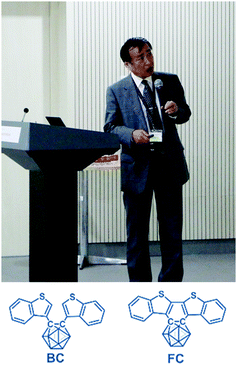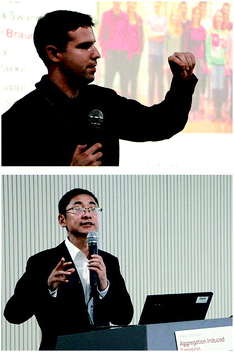Highlights from Faraday Discussion: aggregation-induced emission
Zeyan
Zhuang
a,
Youhong
Tang
*b,
Dan
Ding
c,
Youichi
Tsuchiya
d and
Zujin
Zhao
*a
aState Key Laboratory of Luminescent Materials and Devices, South China University of Technology, Guangzhou 510640, China. E-mail: mszjzhao@scut.edu.cn
bCentre for NanoScale Science and Technology, Flinders University, South Australia 5042, Australia. E-mail: youhong.tang@flinders.edu.au
cState Key Laboratory of Medicinal Chemical Biology, Key Laboratory of Bioactive Materials Ministry of Education and College of Life Sciences, Nankai University, Tianjin 300071, China
dCenter for Organic Photonics and Electronics Research (OPERA), Kyushu University, 744 Motooka, Nishi-ku, Fukuoka 819-0395, Japan
First published on 7th March 2017
“United we stand.” A gathering where ideas clash and crash would push science and technology forward. This is precisely what Faraday Discussions are consistently committed to doing. This unique conference dates back to the 1900s when the first forum was held in London and stands out for its distinctive format where interactive, extensive and in-depth discussions are sparked. Before the meeting, full papers submitted by speakers a few months in advance are distributed to all delegates in order to facilitate adequate preparations for queries and comments. During the conference, the speakers, in groups of two to four, present a 5 minute summary of their work, each followed by lively discussion on each presented paper for 15 minutes, which is practically “live peer-review”. Each group concludes with 20–40 minutes of general discussion focusing on horizontal and longitudinal contrasts between each piece of work as well as more macroscopic issues in the field. This format distinguishes Faraday Discusssions from other conferences.“Together we shine.” Luminescent materials with high efficiency in an aggregate state have great value in fundamental research and practical applications. The emergence of aggregation-induced emission (AIE) illuminates the path to the exploration of practically useful solid-state luminescent materials in a field previously hindered by the frustrating aggregation-caused quenching (ACQ) effect. There is now huge worldwide enthusiasm for AIE and the outputs of AIE research have increased exponentially during the past fifteen years.
Faraday Discussion 196: aggregation-induced emission captured this hot topic and officially kicked off at the South China University of Technology, Guangdong, China, on 18–20 November, 2016. This meeting brought together around 100 researchers coming from Australia, Canada, India, Italy, Japan, Singapore and China to discuss recent progress, current challenges and potential breakthroughs in the design of new AIE luminogens (AIEgens), understanding of the AIE mechanism(s) and the exploration of advanced technological applications (Fig. 1).
The meeting was opened with the welcoming address from the Chair of the Scientific Committee, Professor Ben Zhong Tang (The Hong Kong University of Science and Technology), who first proposed the concept of AIE. Subsequently, Tom Wilson and Polly-Anna Ashford, the Royal Society of Chemistry Publishing Editors, outlined the discussion format. They also took on the task of recording the proceedings during the whole meeting for publication in the journal Faraday Discussions.
Introductory lecture
The introductory lecture was presented by Professor Deqing Zhang (Chinese Academy of Sciences). In this elaborate overview, he emphasised recent progress in the science and application of AIE, starting with the highlight of the restriction of intramolecular motion (RIM), involving rotation (RIR), vibration (RIV), etc. mechanism which is the most comprehensive hypothesis on the working principle of AIE. Prof. Zhang presented some typical high-tech applications of the new AIEgens: sensing and imaging, stimuli responses, organic light-emitting diodes (OLEDs), emissive and semiconducting materials (DOI: 10.1039/c6fd00218h). What was the most valuable was that the talk concluded with the current advantages of, and further investigations for, each application above. It was pointed out that fluorescence sensing and imaging with AIEgens has the advantage of low background signal, simplified sample preparation and high photo- and bio-stability, while further investigations are expected to develop multi-mode imaging and multifunctional AIE probes. Stimuli-responsive AIE materials deserve more investigation focused on their sensitivity, accuracy and multiplex-response. As for OLEDs, many AIEgens have been designed to fabricate full-color or white OLEDs with high performance, and further strategies to exploit new AIE-based OLEDs will involve combining AIE with thermally activated delayed fluorescence (TADF), room-temperature phosphorescence (RTP) and other new concepts. On the other hand, the construction of AIEgens with both semiconducting and emissive properties to fabricate organic light-emitting field-effect transistors and organic lasers is still a great challenge, but a huge amount of room exists for the development of such dual functional materials. This inspiring and foresighted opening lecture set up a general framework and dialectical tone for the following discussion.Session 1: New and efficient fluorescent and phosphorescent luminogens
The first session was grouped into four parts. The first part, chaired by Prof. Ben Zhong Tang, had a creative start with the paper presented by Professor Yoshiki Chujo (Kyoto University) who described new kinds of AIE-active organoboron complexes with a distinctive core unit, o-carborane (1,2-dicarbadodecaborane). Based on the comparison of experimental and theoretical results between BC with flexible peripherals and FC with fused peripherals (Fig. 2), Prof. Chujo proposed a potential strategy for developing boron-containing AIEgens by strengthening the freedom of intramolecular mobility, which is proven to be feasible in two other conventional boron-containing luminescent dyes (DOI: 10.1039/c6fd00155f). The subsequent discussion focused on the inherent properties of the particular carborane unit. From Prof. Chujo's explanation, carborane, as a strong electron acceptor, shows no fluorescence itself, but emits intensely when combined with electron-donating groups. As for the heteroatom-containing AIEgens, Prof. Chujo emphasized that element-blocks are promising candidates not only for new AIEgens but also for a new series of optical materials. The second presentation, given by Miss Kun Wang (Beihang University), introduced a class of novel aggregation-induced emission enhancement (AIEE)-active polyurethanes containing tetraaryl-buta-1,3-diene (TADB) (DOI: 10.1039/c6fd00175k). Concerns about the stability of this emerging AIE-core were raised in the discussion. Actually, TADB shows decent thermal and chemical stabilities and can be easily symmetrically obtained with high stereoselectivity in addition.1 What's more, a common question about the attribution of the abnormal emission peak located in the shorter-wavelength region was raised. It was speculated that this is attributed to Raleigh scattering, which requires more careful investigation in the future. Following this, Prof. Cheng-Chung Chang (National Chung Hsing University) described a kind of water soluble fluorescent organic nanoparticles (FONs), which could be used to build up a double emission enhancement (DEE) system by combining AIEE and metal-enhanced fluorescence (MEF) models in the presence of silver nanowires (AgNWs) (DOI: 10.1039/c6fd00164e). Prof. Chang then meticulously answered several questions raised from the audience about the interaction between the FONs and AgNWs as well as the sequential plasmon-enhanced emission. The main topic of the general discussion was generated from Prof. Yoshiki Chujo's work and focused on the transformation from ACQ to AIE.Following a break for tea, Professor Govindarajan Krishnamoorthy (Indian Institute of Technology Guwahati) discussed an AIEE-active excited state intramolecular proton transfer (ESIPT) dye which has two distinct emissions: a less Stokes shifted normal emission of enol and a highly Stokes shifted tautomer emission of keto, due to ESIPT. Prof. Krishnamoorthy then presented the application of the compound in ion sensing and cell imaging (DOI: 10.1039/c6fd00171h). The speaker and audience debated whether it is essential to re-estimate the exact content of water/THF within cells for imaging applications. The next paper was presented by Dr Feng Zhang (Beijing Institute of Technology) who described interesting CH3NH3PbBr3 nanocrystals fabricated by using tetraphenylethylene (TPE) derivatives as surface ligands as shown in Fig. 3 (DOI: 10.1039/c6fd00167j). Dr Zhang discussed the influence of chain length in TPE derivatives (when n = 3, 4 and 8) on the assembled superstructures and optical properties of the nanocrystals. This innovative work impressed the audience, who expressed interest in the role of AIEgens compared with others. As Dr Zhang stated, further efforts on this work will focus on the fabrication of electroluminescent devices, and the impact of the heavy atom effect will also be investigated, which was eagerly anticipated. Furthermore, it also drew an active discussion about the intermolecular interactions among AIE molecules. The closing presentation of the first day was given by Mr Lingwei Kong (Beijing Institute of Technology). He discussed the fluorescence detection of amine vapors prepared by simply depositing a dimalononitrile-containing AIEgen, 1Z,3Z-hexaphenylbutadiene modified by dimalononitrile, on the filter paper, whose detection limit reaches 1 ppb under UV light and reaches 1 ppm with the naked eye (DOI: 10.1039/c6fd00178e). The following discussion concentrated on some details of the detection experiment as well as the inherent mechanism. Moreover, the photo-stability of the molecules was queried and the author acknowledged that there was a partial isomerization change under a UV lamp of 254 nm after 4 hours.
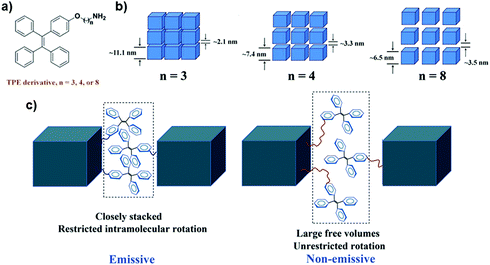 | ||
| Fig. 3 (a) The molecular structure of the TPE derivatives with different chain length (n = 3, 4, or 8) shown by Dr Feng Zhang, (b) schematic diagram of the nanocrystals with TPE derivatives (n = 3, 4, or 8) and (c) schematic illustration of the assembly of the nanocrystals with TPE derivatives with long (left) or short (right) chain lengths. Reproduced from DOI: 10.1039/c6fd00167j with permission from the Royal Society of Chemistry. | ||
The first work of the second day was presented by Professor Andrea Pucci (Università di Pisa). He described julolidine-functionalized styrene copolymers used for the fast detection of volatile organic compounds (VOCs) in a saturated atmosphere, due to viscosity-dependent emission (DOI: 10.1039/c6fd00151c). The sensitivity of this sensor was queried by the audience, but the detection limit had not been figured out. The viscosity-dependent polymers were considered as qualified candidates to report the damaged condition of plastic engineering components. The discussion then turned to the requirement to standardise sensor devices as commercially repeatable products. For this, high selectivity was perceived as an essential but pivotal feature that was difficult to find in many papers (Fig. 4). The second paper illustrating the structure–property relationship of an AIEgen with donor–π–acceptor (D–π–A) structure was briefly described by the Chair due to the regretful absence of the author, Professor Ram Adhar Singh (Banalas Hindu University) (DOI: 10.1039/c6fd00158k). Several questions raised by the audience were communicated to the author and his responses are included in the Faraday Discussions volume. Next, Professor Dario Pasini (University of Pavia) reported a series of D–π–A dyes formed of a central vinyl stator and several rotors and discussed how the “push–pull” characteristics of the substituents influenced the optical properties, especially the AIE behaviours (DOI: 10.1039/c6fd00161k). Since the family in Prof. Pasini's work had more than 20 compounds including his previous related work,2 it was an uphill but fulfilling work to systemize the structure–property relationships, which is what most of the discussion concentrated on. Although the translation of molecular design into photophysical properties is far from straightforward, this work provided useful guidance on the road to discovery.
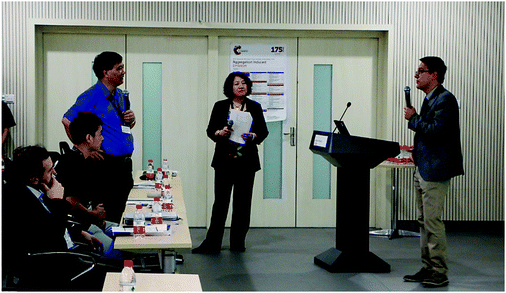 | ||
| Fig. 4 Prof. Ben Zhong Tang (left) discussing with the speaker, Prof. Andrea Pucci (right), chaired by Prof. Wenjing Tian (middle). | ||
The final part of this session was wrapped up with a single presentation given by Professor Ping Lu (Jilin University), due to the absence of Professor Jin-Long Hong (National Sun Yat-sen University). Prof. Lu exhibited a group of comparative studies on two analogue AIEgens, PICNDSB and CzCNDSB, displayed in Fig. 5a, in which PICNDSB exhibites stronger intramolecular charge transfer (ICT) properties and a higher two-photon absorption cross section compared with CzCNDSB, demonstrating the potential of cyclopenta[b]indole as a valuable construction unit in the field of photoelectronics (DOI: 10.1039/c6fd00159a). Plenty of time remained in the session, providing an opportunity to extensively discuss Prof. Lu's work. The themes of the discussion fastened primarily on the following aspects: the mechanochromic properties of CzCNDSB reported in Prof. Lu's preceding paper (Fig. 5b),3E/Z isomerization and the AIE behaviours of PICNDSB. The first topic was the most-watched content as a result of people's eager pursuit for commercial applications of pressure sensors as well as the breakthrough development of mechanobiology. It was noted that reversible mechanochromophores with pico- to nano-Newton response were desirable for mechanobiology. Incidentally, a common mistake found in some articles was pointed out by Prof. Govindarajan Krishnamoorthy. Absorbance is a dimensionless quantity which should not carry unit when used as label of the Y-axis in the absorption spectra. In the time remaining, the chair introduced Prof. Jin-Long Hong's paper in brief and collected questions to communicate to the author later. After the meeting, the author answered questions from the participants about the terminology of sensor, probe and indicator.
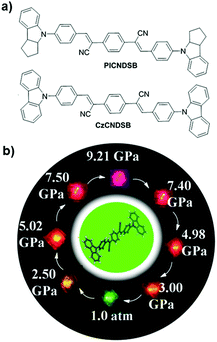 | ||
| Fig. 5 (a) The molecules shown by Prof. Ping Lu, reproduced from DOI: 10.1039/c6fd00159a with permission from the Royal Society of Chemistry. (b) Images of CzCNDSB crystal in diamond anvil cell (DAC) during a pressurizing and depressurizing cycle, excited by a laser (λex = 355 nm). Reproduced from ref. 3 with permission from the Royal Society of Chemistry. | ||
Session 2: Advanced functional luminogens in the solid-state
The session was kicked off by Professor Wenjing Tian (Jilin University). She investigated two polymorphs of a co-crystal with BP4VA and FIB through supramolecular self-assembly (Fig. 6) and discussed the relations among supramolecular interactions, stacking modes and photophysical properties (DOI: 10.1039/c6fd00166a). The intriguing co-crystal system captivated the audience who expressed an interest in replacing FIB with triiodobenzene or trifluorobenzene. What's more, a discussion was stimulated by the ICT feature of BP4VE, focused on the AIE events of the luminogens with ICT or twisted intramolecular charge transfer (TICT) characteristics. The next paper was presented by Dr Fuyuki Ito (Shinshu University) who described a useful method named multivariate curve resolution-alternating least squares (MCR-ALS) to analyse the evolution of AIE and demonstrated main species in binary solution (DOI: 10.1039/c6fd00162a). This interesting work received a high evaluation from the audience on account of the significance and complexity of the process of the molecules’ self-assembly. Further optimization was expected to invent a general tool applied to various molecular systems. Afterwards, Professor Anjun Qin (South China University of Technology) showcased a tetraphenylbenzene (TPB) cored luminophore with D–π–A structure which showed potential for use in emitting layers to fabricate deep blue OLEDs (DOI: 10.1039/c6fd00162a). During the discussion, several inquiries into the photophysical properties of the TPB derivative and the deeper interpretations were put forward. The general discussion of the above three papers was led by Prof. Yoshiki Chujo and centred on the purification and purity of the target compounds. | ||
| Fig. 6 Schematic illustration of the co-crystal system and chemical structures of BP4VA and FIB described by Prof. Wenjing Tian. Reproduced from DOI: 10.1039/c6fd00166a with permission from the Royal Society of Chemistry. | ||
Following this, Professor Eric Rivard (University of Alberta) presented his research on a borylated tellurophene with photoluminescence whose emission could be modulated by adding an equivalent coordinating Lewis base, N-heterocyclic carbine (DOI: 10.1039/c6fd00172f). The environmental and chemical stabilities of this new class of phosphorescent tellurophenes was the main topic in the discussion. The next paper, reported by Professor Osamu Tsutsumi (Ritsumeikan University), demonstrated mesogenic Au complexes showing aggregation-induced enhancement of phosphorescence in both crystalline and liquid-crystalline phases (DOI: 10.1039/c6fd00157b). An active debate about the essence of the Au–Au interaction ensued. In the course of the discussion, Professor Jingzhi Sun (Zhejiang University) proposed an interesting opinion that the emission process of the mesogenic Au complexes could be considered as a new unique style called aggregation-induced formation of the luminogen. Prof. Sun was also the next presenter and showcased work covering the insertion of two ionic AIE-active fluorescent probes with opposite charges into bovine serum albumin (BSA) in order to disclose the unfolding and refolding processes of BSA (DOI: 10.1039/c6fd00165c). Further discussion of this paper was focused on whether the monomer or the aggregate emitted inside BSA. In addition, the binding ability of the monomer or the aggregate BSA, compared with DNA, was also a concern for the audience (Fig. 7). The finale of this section was the very inspiring work reported by Professor Pengfei Duan (National Center for Nanoscience and Technology). The concepts of aggregation-induced photon upconversion (iPUC) and supramolecular chemistry were subtly combined, which produced a reversible on–off switching of photon upconversion system in self-assembled organogel (Fig. 8, DOI: 10.1039/c6fd00170j). This research generated a lively discussion. There was a great interest in the design, construction and performance of triplet–triplet annihilation-based photon upconversion (TTA-UC). Eventually, a general question about next generation of AIE materials was raised by Professor Mingqiang Zhu (Huazhong University of Science and Technology), which was directed to all participants. All agreed with the view that AIE is a general optical phenomenon for diverse compounds including organic, inorganic, organometallic and hybrid luminogens. As Professor He Tian (East China University of Science and Technology) said, “The research scope of AIE can be expanded to be as large as you can imagine.”
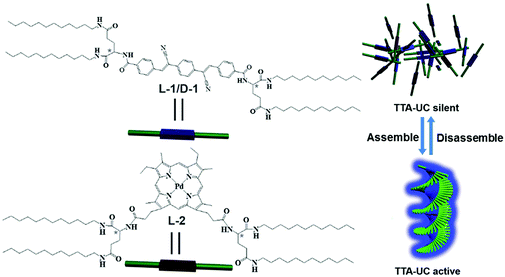 | ||
| Fig. 8 Schematic illustration of the self-assembly-induced TTA-UC shown by Prof. Pengfei Duan. Acceptor molecules (L-1 or D-1) spontaneously co-assemble with donor molecules (L-2) to enable thermal switching of TTA-UC. Reproduced from DOI: 10.1039/c6fd00170j with permission from the Royal Society of Chemistry. | ||
Session 3: Biomedical applications of luminogens
The session got off to a dynamic start with the presentation by Professor Shuizhu Wu (South China University of Technology) who talked about a taurine-containing AIEgen with enhanced cellular uptake capability. When stimulated by the overexpressed esterase in inflammatory cells, the fluorophore was capable of releasing taurine moieties and thus scavenge intracellular reactive oxygen species (ROS) and remained an AIE luminogen moiety as reporter for imaging (DOI: 10.1039/c6fd00118a). A question was raised about how to investigate and modulate the aggregation inside the cell, which was out of reach at present, but deserved further research. What's more, the possible long-term influence of the fluorophore on the cells should also deserve attention. The next speaker in this session was Dr Youhong Tang (Flinders University). He described a quantitative detection system to measure urine albumin–creatinine ratio (UACR) availing of TPE derivatives, which could be utilized to indicate the presence of chronic kidney disease (CKD) (DOI: 10.1039/c6fd00153j). This presentation created a stimulating discussion about the challenges of the real world application of this method when using real urine samples, such as sensitivity, selectivity, environmental stability and the conversion from chemical sensor to an electronic signal. Furthermore, Dr Tang's work received a proposal to prepare other AIEgens with emissions in a longer wavelength region on account of the autofluorescence of bio-system. Subsequently, a real-time naked-eye multi-detection model of ricin and B. subtilis with fluorescent light-up signals in different colours by using aptamer functionalized AIE nanoparticles (NPs)/graphene oxide (GO) platform was demonstrated by Ms Ruoyu Zhang (National University of Singapore) (DOI: 10.1039/c6fd00169f). There was much discussion about the effect of the parameters of GO on the results. A more general discussion was active about whether the AIE emission wavelengths can be predicted from chemical structures. In addition, it was pointed out that the linear quantitative detection is both a challenge and an opportunity for the development of AIEgens as sensors in future research.After a short break, Professor Dan Ding (Nankai University) continued the theme of biomedical applications of AIEgens. He presented a turn-off probe for the selective detection of divalent copper ions (Cu2+) in both aqueous solution and live cells (DOI: 10.1039/c6fd00176a), in which the underlying mechanism had not been evidently mentioned, but captured the audience's attention. The discussion raised around this work was focused on the comparison between fluorescence turn-on and turn-off modes. As a matter of fact, a fluorescence light-up probe is much more advantageous to realize accurate and reliable detection. A constructive suggestion was given by Dr Xiaoding Lou (Huazhong University of Science and Technology) about how to convert the reported turn-off probe to a good turn-on cyanide one. Afterwards, Prof. He Tian proposed a new concept of vibration-induced-emission (VIE), referring to dual fluorescence emission produced by the vibration of a single molecule, in his presentation which touched on the selective detection and imaging of amyloid β fibrils (DOI: 10.1039/c6fd00156d). The heartening talk of Prof. Tian urged all participants to actively engage in the discussion revolving around the mechanisms of VIE. During the discussion, he compared VIE with AIE in terms of the applications of sensing and bioimaging and described some related investigations they had done. Professor Bin Liu (National University of Singapore) eventually highlighted that the understanding of the intrinsic mechanism was of great significance for the whole community (Fig. 9).
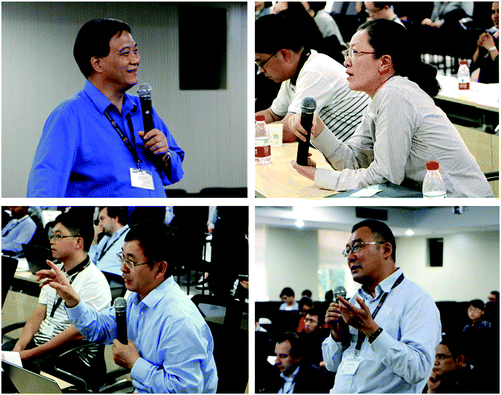 | ||
| Fig. 9 Prof. Ben Zhong Tang (upper left), Prof. Bin Liu (upper right), Prof. Deqing Zhang (lower left) and Prof. Yuguang Ma (lower right) were discussing with the presenters. | ||
Session 4: Optoelectronic devices of highly efficient luminogens in the solid state
The final session of the meeting took place in the afternoon of the last day, starting with the report from Professor Yuguang Ma (South China University of Technology). He gave a talk on a targeted quantitative investigation on the piezochromic effect under different pressure conditions of a kind of AIE crystal by means of synchronous Raman scattering and fluorescence spectroscopies (DOI: 10.1039/c6fd00154h). Further discussion of this paper was focused on the phase transition behaviours of AIEgens, which were considered to be worthy of deeper study. Next, Professor Zhen Li (Wuhan University) followed with a paper about a turn-off test paper for hypochlorite (OCl−) with high selectivity, fast response and low detection limit (DOI: 10.1039/c6fd00154h). In addition to some questions about the detection mechanism, a heated debate occurred as to whether the reported sensor could actually be applied to tap water analysis. There were two aspects of the problem. One was the interference with the results from the complicated components of tap water. Accordingly, further investigations on the selectivity in a mixed system, rather than a simplex system, were necessary, which was also an integrant point in future research on the engineering applications of sensors. The other aspect was the grossly flawed turn-off mode. Although most adopted a pessimistic attitude to the compromising mode, Prof. Li insisted that the advantages of turn-off sensors were dormant but waiting to be tapped. The presentations for this topic ended with the work of Prof. Mingqiang Zhu. He showcased work covering a series of monomers and polymers based on tetraphenylethene substituted with naphthalimide at the 4, 6 positions, which showed potential as solvent probes, thermo-sensitive sensors and mitochondria targeting imaging trackers as displayed in Fig. 10 (DOI: 10.1039/c6fd00160b). Wherein, polymer bio-sensors as an unexplored field aroused active debates on the cellular uptakes of polymers. Discussion eventually hit upon a point that comparative experiments should be carried out between AIEgen-based probes and commercially common dyes, which was actually broadly important to demonstrate the utility of AIEgens for real world applications.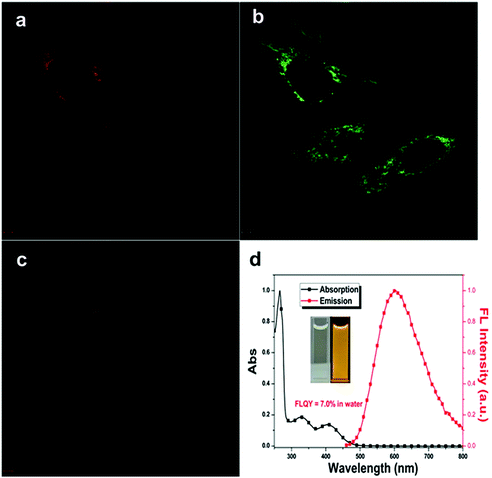 | ||
| Fig. 10 Confocal microscopy of live HeLa cells treated with (a) the polymer probe, (b) commercial MitoTracker (Deep Red FM), (c) the merged images of (a) and (b), and (d) absorption and fluorescence spectra of the polymer in water. Scale bar is 15 mm. This work was presented by Prof. Mingqiang Zhu. Reproduced from DOI: 10.1039/c6fd00160b with permission from the Royal Society of Chemistry. | ||
Concluding remarks lecture
To conclude the meeting, Prof. Bin Liu gave the concluding remarks lecture entitled “The Wonderful World of AIEgens”. She took the audience back through the key milestones in the developing history of AIE, which fell into three stages. The first five years from 2001 to 2005 were considered to be the initial and discovery stage, in which the budding concept of AIE faced the greatest challenge to impact the ingrained thinking patterns of fighting against aggregation. The next five years from 2006 to 2010 were doomed to be the defining and propagating stage where various AIEgens with novel functions were exploited and AIE work was expanding beyond China. In the most recent five years, AIE research has achieved a flourishing and booming stage with an expanding scope of practice applications and increasing international attention. Shortly afterward, Prof. Liu recapitulated a series of brilliant achievements by highlighting some representative literature. Finally, she concluded with a classical proverb “United we stand, together we shine!” which expressed infinite expectations of this promising field and issued invitations to the 3rd International Symposium on AIE to be held in Singapore, 18–23 June 2017, which could be regarded as a perfect connecting link between the preceding and the following. This heart-stirring speech greatly inspired the enthusiasm of all the participants to devote themselves to the deeper research of AIE.Acknowledgements
This work was financially supported by the National Key Basic Research and Development Program of China (973 program, 2013CB834702) funded by MOST, the Guangdong Innovative Research Team Program of China (201101C0105067115), the Guangdong Natural Science Funds for Distinguished Young Scholar (2014A030306035), the Natural Science Foundation of Guangdong Province (2016A030312002), the Innovation and Technology Commission of Hong Kong (ITC-CNERC14SC01) and the Fundamental Research Funds for the Central Universities (2015ZY013).References
- T. Han, Y. Zhang, X. Feng, Z. Lin, B. Tong, J. Shi, J. Zhi and Y. Dong, Chem. Commun., 2013, 49, 7049 RSC.
- (a) E. Cariati, V. Lanzeni, E. Tordin, R. Ugo, C. Botta, A. Giacometti Schieroni, A. Sironi and D. Pasini, Phys. Chem. Chem. Phys., 2011, 13, 18005 RSC; (b) C. Coluccini, A. K. Sharma, M. Caricato, A. Sironi, E. Cariati, S. Righetto, E. Tordin, C. Botta, A. Forni and D. Pasini, Phys. Chem. Chem. Phys., 2013, 15, 1666 RSC.
- C. F. Feng, K. Wang, Y. X. Xu, L. Q. Liu, B. Zou and P. Lu, Chem. Commun., 2016, 52, 3836 RSC.
| This journal is © The Royal Society of Chemistry 2017 |


